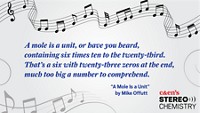Advertisement
Grab your lab coat. Let's get started
Welcome!
Welcome!
Create an account below to get 6 C&EN articles per month, receive newsletters and more - all free.
It seems this is your first time logging in online. Please enter the following information to continue.
As an ACS member you automatically get access to this site. All we need is few more details to create your reading experience.
Not you? Sign in with a different account.
Not you? Sign in with a different account.
ERROR 1
ERROR 1
ERROR 2
ERROR 2
ERROR 2
ERROR 2
ERROR 2
Password and Confirm password must match.
If you have an ACS member number, please enter it here so we can link this account to your membership. (optional)
ERROR 2
ACS values your privacy. By submitting your information, you are gaining access to C&EN and subscribing to our weekly newsletter. We use the information you provide to make your reading experience better, and we will never sell your data to third party members.
People
Chemistry is the most creative of the sciences. But is it beautiful?
by Bibiana Campos-Seijo
May 22, 2021
| A version of this story appeared in
Volume 99, Issue 19
“Nature [is] herself a brilliant chemist and by far the best engineer of all time.”
Frances Arnold, 2018 chemistry Nobel Prize laureate, spoke these words during her Nobel lecture. Philip Ball included the quotation in his recently published book The Beauty of Chemistry: Art, Wonder, and Science, which features photography by Yan Liang and Wenting Zhu.
I attended a virtual presentation hosted by the UK’s Royal Institution where Ball, Liang, and Zhu discussed the meaning and importance of beauty in the sciences and, specifically, chemistry.
We can all agree that chemistry is the most creative of all the sciences. Ball, a science writer who worked as an editor of the Nature journals for more than 2 decades, described chemistry as the science with “the greatest urge to make,” with chemists engineering creations by uniting and rearranging atoms to achieve different shapes and properties, sculpting molecules that rival the beauty and complexity of those seen in nature.
But what makes chemistry beautiful? Ball made no apologies for using the term beauty but acknowledged that it is a “complicated word.” What makes an experiment beautiful, and how is this different from what makes a molecule beautiful? How does a chemist define beauty in science compared with, say, a physicist?
What beauty might describe in the sciences is different from what it might describe in the world of art and aesthetics. Ball acknowledged that beauty has been banished from discussions in art theory as artists and theorists would argue that the purpose of art is not necessarily or exclusively to make beautiful things.
What a chemist understands as a beautiful molecule varies a lot. At the end of each year, C&EN asks our readers to vote on their favorite molecule of the year, with things as varied as ionic liquids and molecular knots topping the list. In his talk, Ball pointed to the structure of C60, which has a perfect polyhedral shape, to suggest that chemists tend to be Platonists, “often locating beauty in symmetry and perfection.” For Plato, “art was too messy to be truly beautiful,” Ball said. By contrast, he continued, for philosopher Immanuel Kant, “beauty depends on a departure from the regular and the beautiful.” In Kant’s own words, “All stiff regularity . . . has something in it repugnant to taste.”
Whichever side of the argument you are on, Ball argued that “the beauty in chemical processes too often passes unseen or acknowledged as chemical in nature” as we fail to realize that chemistry is as much at work in the fragrance of a flower or the formation of a snowflake as it is in oil refineries and pharmaceutical plants. He added that beauty in chemistry—and in the images that have gone into the book—is not necessarily intrinsic to the objects or processes in the photos but comes from the skill, both technical and aesthetic, in deciding how to portray them. These images were not obtained casually; they were carefully composed, captured, and selected to help us observe and discover. They work “to reveal what is there, what lies underneath the surface,” which, according to Ball, “is where science really begins: with noticing.”
The photography of Liang and Zhu, who have occasionally contributed to C&EN’s Chemistry in Pictures—a collection of chemistry images submitted by readers—has helped us observe mundane phenomena such as bubble formation in a way that piques your curiosity and asks questions like “Why do they move the way they do?”
Ball said that he, Liang, and Zhu hope that The Beauty of Chemistry rehabilitates the common perception of chemistry and shows how it continues to find the beautiful in the mundane. “Science doesn’t de-enchant the world; on the contrary, it re-enchants.” So it does.
Views expressed on this page are those of the author and not necessarily those of ACS.



Join the conversation
Contact the reporter
Submit a Letter to the Editor for publication
Engage with us on Twitter